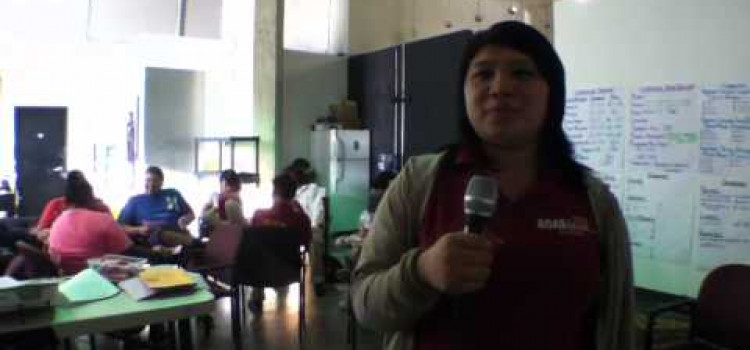

Just down the street from Cabrillo High School in West Long Beach is a fast-food paradise: McDonald’s, Taco Bell, Winchell’s, Carl’s Jr., and a Jack-in-the-Box all on opposite corners of PCH and Atlantic.
Across the street from Jordan High School in North Long Beach is also a McDonald’s and Carl’s Jr., easily visible from inside school gates. The Subway next door also serves pizza.
While junk food is more than readily available to students in Long Beach, some students and teachers are working hard to bring awareness to healthy eating habits.
“Think about what that food is doing to your body,” says Citlali Hernandez, 16 and student leader with Californians for Justice (CFJ). “You say it tastes good, but in 30 years you can be suffering from heart disease, especially in this era of obesity.”
CFJ has started their “Food-for-Thought” campaign, an effort to increase healthy eating habits in youth and build organic gardens in Long Beach.
“It’s no accident that many of our high schools are surrounded by fast-food restaurants,” says Dr. Bill Gibson, professor of Sociology at CSULB who lectures on the fast-food industry. “Looking at intersections, schools, and shopping centers are all considered good business tactics,” he adds.
Forty-one percent of Long Beach’s minors were obese or overweight in 2010 according to studies by the UCLA Center for Health Policy Research.
Valeria Ramos, a 9th grader at Cabrillo, usually goes to the nearby McDonald’s for breakfast because she doesn’t have time to catch it at home.
“I love it, I come here every day and I get the sausage McMuffins,” Ramos said.
In her grade level, one out of five students is obese, according to 2010 records from the Long Beach Community Database.
“The food is bomb,” said Shakur Hicks, 9th grader from Jordan High, as he sipped his large McDonald’s drink. “It’s cool to come after school, just across the street…to kick it.” The giant panther emblem that adorns the school’s building is seen from the McDonald’s drive-thru.
Much of the food industry research budget goes into finding the additives that will trigger responses in consumers and keep them going without triggering satiation, according to Gibson. “We’re wired to crave it,” Gibson said.
But students aren’t the only ones making strides. There are teachers who are advocates for health too.
Kelly Leech is a coordinator with the HealthCorps at Cabrillo High School. There is a big problem with diabetes and obesity on campus, according to her observations.
“[It’s] probably correlated to the fact that healthy food is limited,” she says. Leech teaches weekly nutrition and fitness classes at the school as part of the HealthCorps curriculum, a nationwide program aiming to teach students healthier life decisions.
“I’ll ask, ‘How many of you know someone with diabetes?’ and most of them raise their hands,” Leech said.
In her class activities, Leech covers health skills such as how to read nutritional labels, choosing wheat over white and colored veggies over plain food.
“I do believe we’re making an impact with that knowledge…but if there’s no environment for it, you can only go so far,” Leech said, highlighting the need to bring in stores and restaurants with healthier brands into the area.
Students say they may skip school lunch because of its lack of taste, according to CFJ. This leaves students hungry after school and vulnerable to the vast assortment of fast-food options outside their campuses.
“The quality in the school food is not that great so people often go to buy things that are ‘better’,” says Jose Luis Nava, a youth activist with CFJ.
The lead organizer for CFJ is Jennifer Harris. The group is calling on the school district to change its lunch menu.
“We’ve been collecting surveys from students and petitions from community members and plan on raising more awareness for more fresh fruits and vegetable in schools that include vegan and vegetarian options,” Harris said.
CFJ youth activists are currently writing op-ed pieces of their experiences, such as finding school milk rotten, and encountering other school foods that just didn’t taste right. They plan on submitting their pieces to local media.
Perhaps another draw to fast food is free wireless Internet. Each of the McDonald’s located by Long Beach high schools also have free Wi-Fi. Students say that the internet speed is slow, but some did say that they may use the Wi-Fi to do homework or Instagram, perhaps a tempting alternative when public libraries are closed on Sundays and Mondays.
“Getting people to change is not impossible,” says Dr. Gibson. “There is an indirect way to get at the fast-food issue, that you expose children to healthy food at a younger age in the school system, to where it’s not just healthier, it actually tastes good.”
What do you think about the fast-food and schools issue in Long Beach? Post your comments below.
For more information, click on the resources below.
Problems, Treatment, and Coping with Child Obesity
How to Choose Healthier Options at Fast Food Joints
